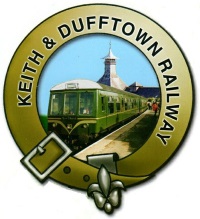Multiple Units
B.R. Derby Class 108 DMU “Spirit of Speyside” See them in their heyday!
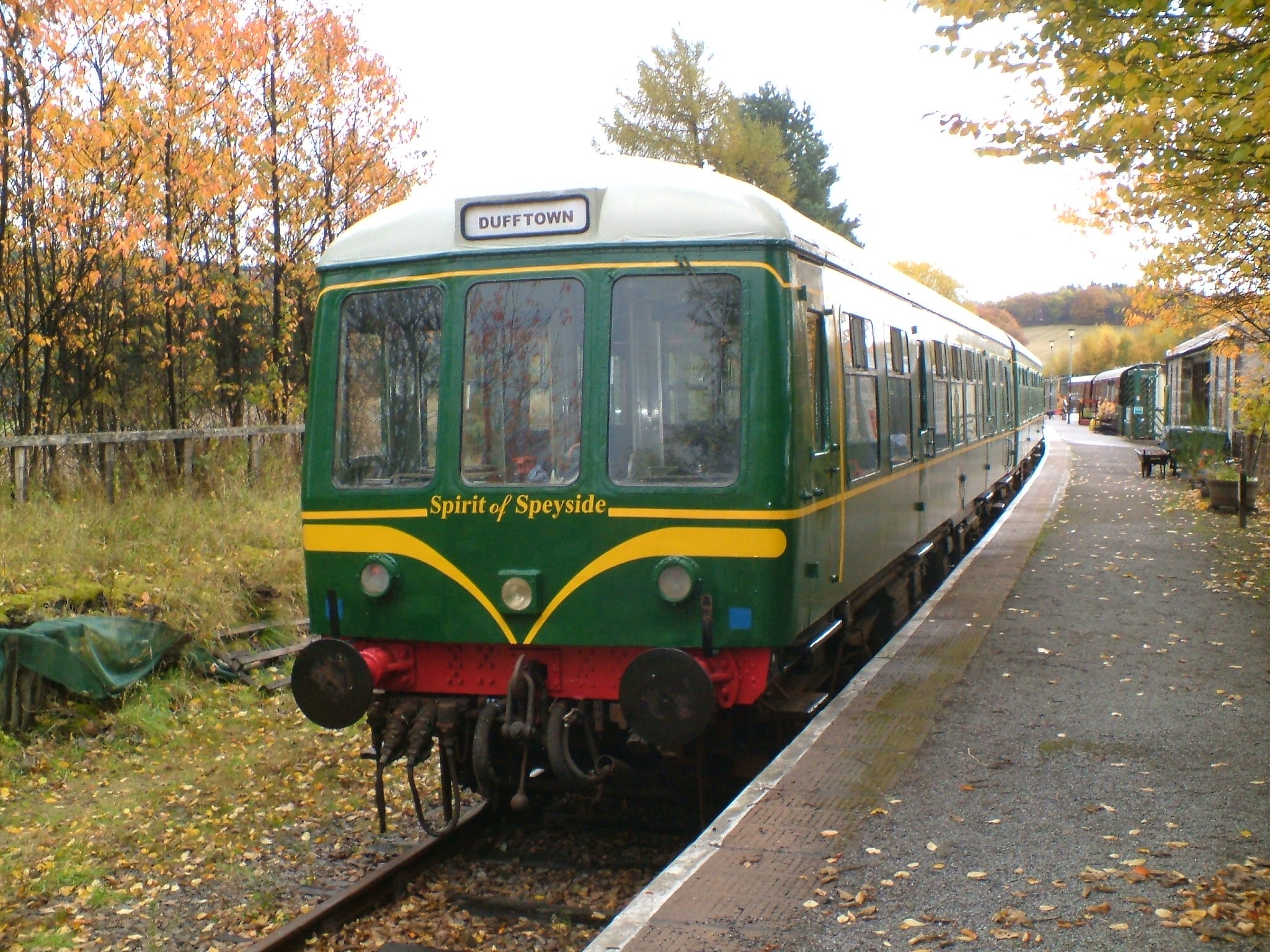
Dufftown car 53628
This standard DMU was built by BR’s Derby workshops in 1958 and numbered M50623 (53628) it was originally partnered by M56223 (54223). Little is known at present about the vehicles’ early histories, but by 1977 both had found their way to the Manchester / Chester area where they worked until the late 1980s. 53628 then headed south to Oxfordshire, while 54223 headed further to Marylebone for a year prior to joining its sister in Oxfordshire. 54223 became the last Class 108 in public service prior to its withdrawal in October 1993 from Old Oak Common depot (53628 was withdrawn in June of that year) and both cars were stabled at Southall until 1998 when they moved to the East Anglian Railway Museum. The unit arrived at Dufftown on 7th March 2000. 54223 left the railway in exchange for M56491 which was in turn replaced by 56224. 53628 is a Driving Motor Brake Second (DMBS) having a guard’s compartment. This unit (53628) was repainted into the BR green livery as shown above in late 2012 / early 2013.
Keith car 56224
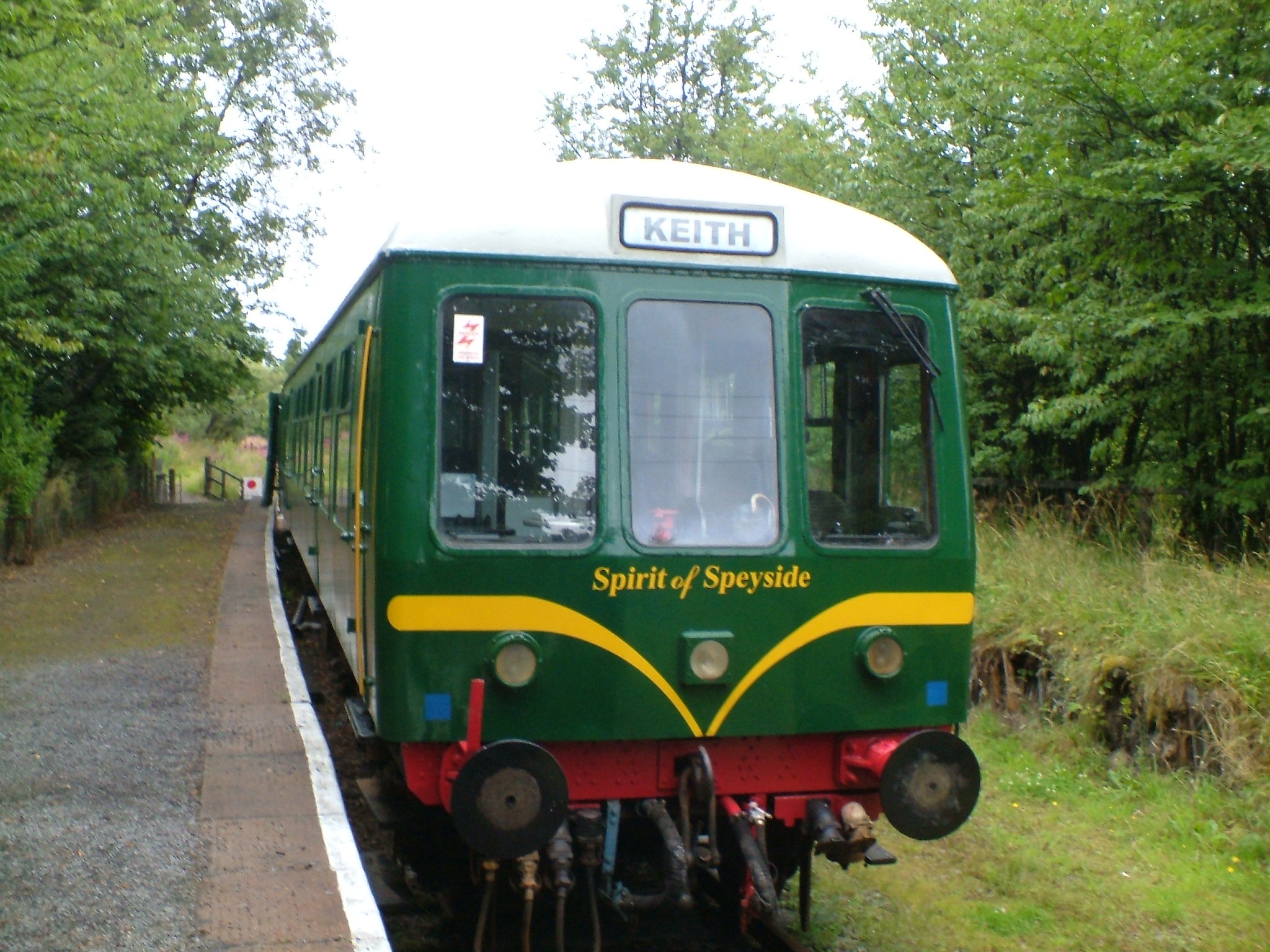 Class 108 Driving Trailer Composite Lavatory DTCL BR 56224 M54224, built by BR’s Derby workshops in 1959 as part of Lot 30466 to diagram number 640. This vehicle, paired with DMBS 50941, went into service on British Railways’ London Midland Region allocated to Bletchley Depot where they worked the Cambridge to Oxford line. The units were first in British Railways DMU green then were repainted around 1967 into rail blue and from about 1980 into blue and grey. Its partner vehicle 50941 has not survived. The set was withdrawn from passenger service sometime between 1990 and 1993. The Vehicle was asbestos free, in good mechanical condition and retained its first class salon. The vehicle went to the Mid Norfolk Railway then to the Ecclesbourne Valley Railway, arriving there in March 2004. Before arriving at Dufftown the vehicle was repainted to rail blue. The unit arrived at Dufftown on 17th March 2010. It can seat 65 passengers. 12 1st class and 53 2nd class. This unit (53628) was repainted into the BR green livery as shown above in late 2012 / early 2013.
Class 108 Driving Trailer Composite Lavatory DTCL BR 56224 M54224, built by BR’s Derby workshops in 1959 as part of Lot 30466 to diagram number 640. This vehicle, paired with DMBS 50941, went into service on British Railways’ London Midland Region allocated to Bletchley Depot where they worked the Cambridge to Oxford line. The units were first in British Railways DMU green then were repainted around 1967 into rail blue and from about 1980 into blue and grey. Its partner vehicle 50941 has not survived. The set was withdrawn from passenger service sometime between 1990 and 1993. The Vehicle was asbestos free, in good mechanical condition and retained its first class salon. The vehicle went to the Mid Norfolk Railway then to the Ecclesbourne Valley Railway, arriving there in March 2004. Before arriving at Dufftown the vehicle was repainted to rail blue. The unit arrived at Dufftown on 17th March 2010. It can seat 65 passengers. 12 1st class and 53 2nd class. This unit (53628) was repainted into the BR green livery as shown above in late 2012 / early 2013.
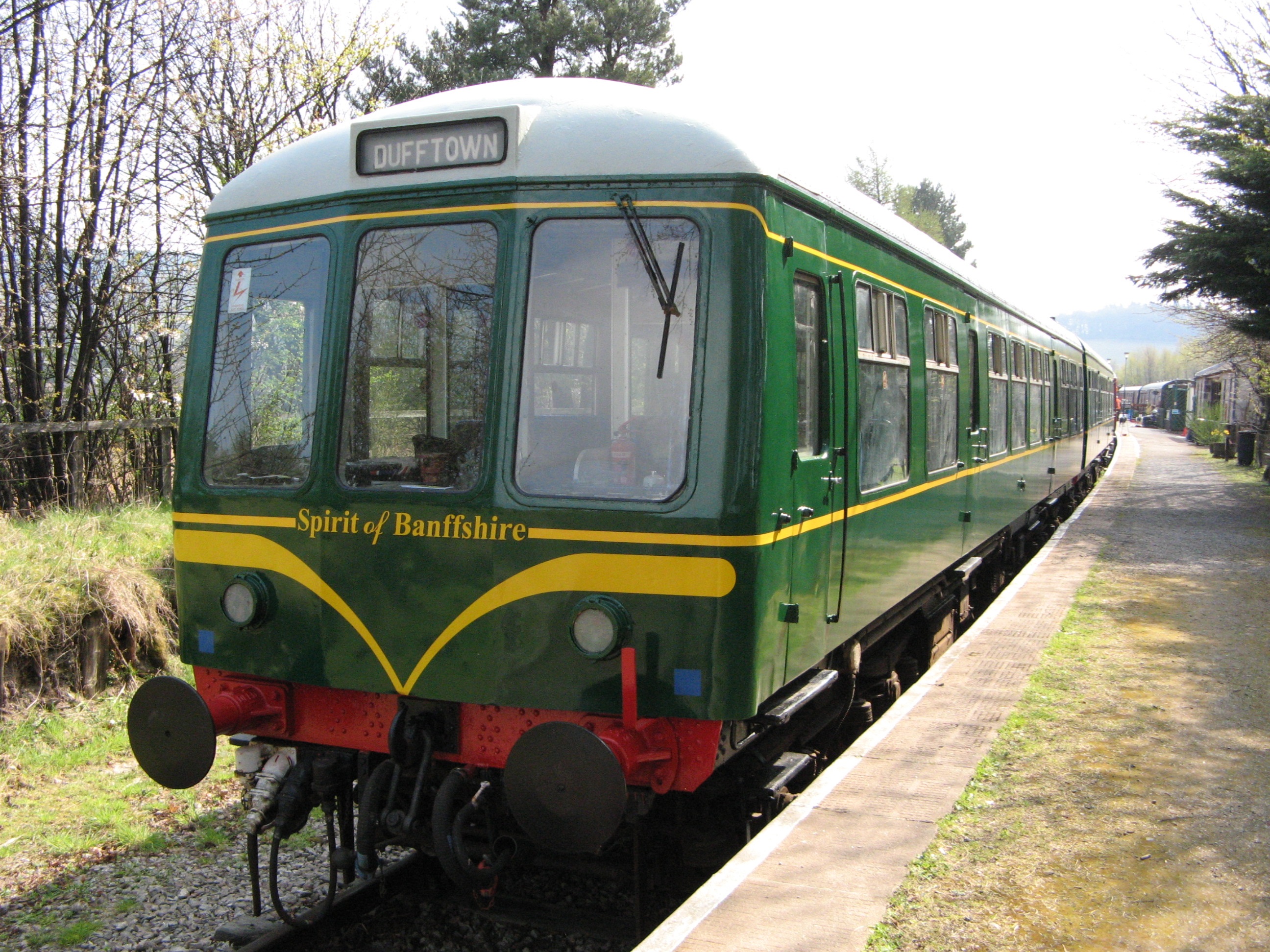
Dufftown car 51568
B.R. Derby Class 108 DMU “Spirit of Banffshire”
Two more Class 108 vehicles arrived at the railway in summer 2001. Both were in green livery and were leased from the Diesel Unit Preservation Associates Ltd. The unit is unusual in being formed of a Driving Motor Standard Lavatory (DMSL) non-brake vehicle and a Driving Motor Composite Lavatory (DMCL) non-brake vehicle providing no guards accommodation, however the “power-twin” arrangement proved very effective on the line’s steep gradients in the early days. Both vehicles were purchased by KDRA in 2005.
The car is a Driving Motor Standard Lavatory (DMSL) non-brake vehicle, providing no guards accommodation. This unit (51568) was repainted into the BR green livery as shown above in 2013.
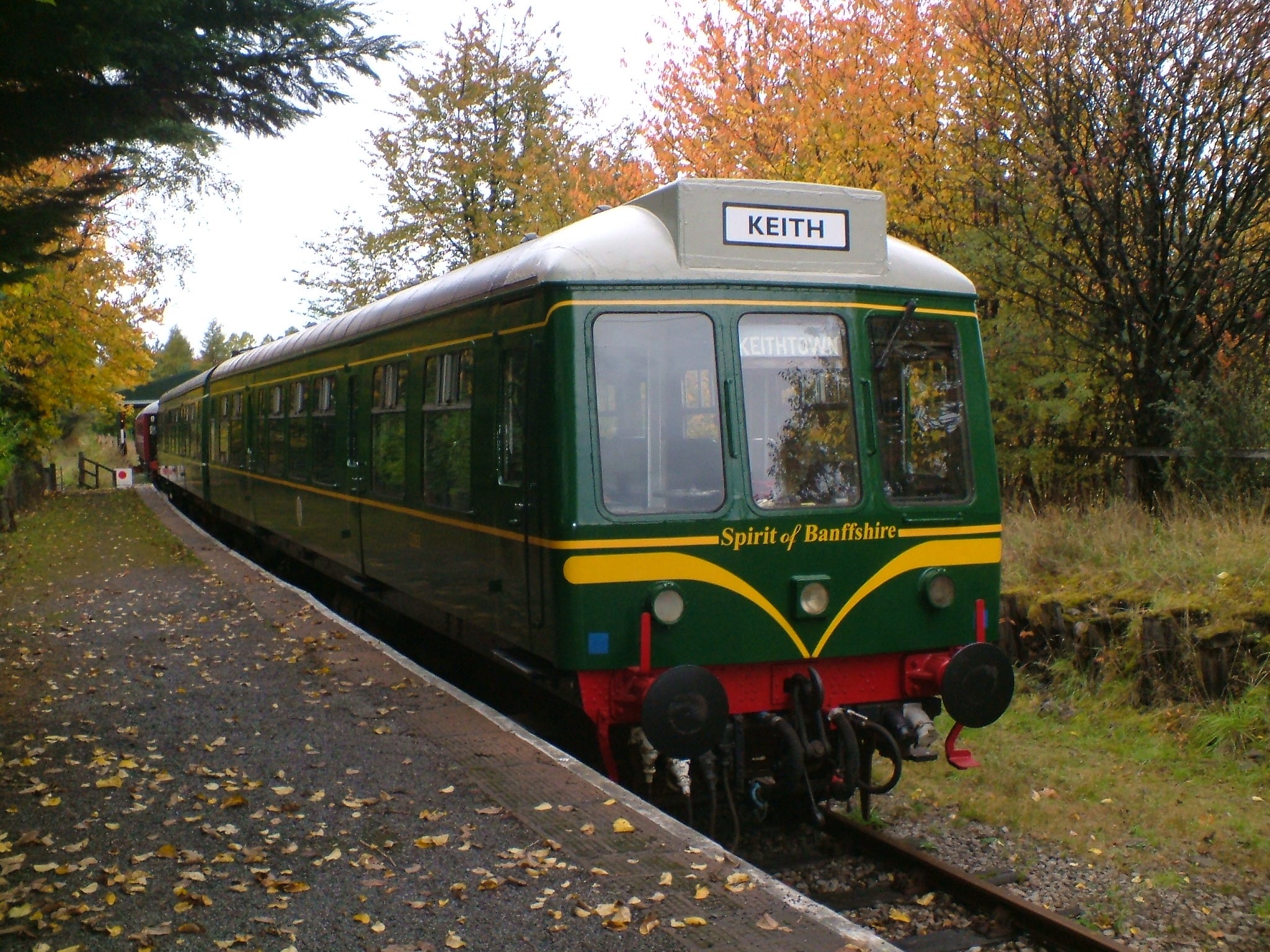
Keith car 52053
The car is a Driving Motor Composite Lavatory (DMCL) non-brake vehicle providing no guards accommodation. This unit (52053) was repainted into the BR green livery as shown above in 2013.
B.R. Derby Class 108 DMU
Driving Trailer Composite Lavatory DTCL M56491
 Little is known at present about the vehicle’s early history, M56491 DTCL was obtained in exchange for 54223 which was the original partner to DMBS 53628 in Spirit of Speyside. M56491 was in turn replaced by DTCL 56224 (see above). M56491 built by BR’s Derby Workshop in 1960 and is a Driver Trailer Composite Lavatory (DTCL) with 3 saloons and toilet facilities. The leading saloon behind the driver’s compartment was formerly the 1st class section but was declassified to 2nd class late in its BR career. This unit arrived at Dufftown in BR green livery and has been repainted into a revised BR green livery as per our other DMU cars. The photo above (by Phin Sloan) shows 56491 as at July 2013 after repainting. This car has now been completely restyled into the “Dram Tram” which can be used for our events and is now available for Hire!.
Little is known at present about the vehicle’s early history, M56491 DTCL was obtained in exchange for 54223 which was the original partner to DMBS 53628 in Spirit of Speyside. M56491 was in turn replaced by DTCL 56224 (see above). M56491 built by BR’s Derby Workshop in 1960 and is a Driver Trailer Composite Lavatory (DTCL) with 3 saloons and toilet facilities. The leading saloon behind the driver’s compartment was formerly the 1st class section but was declassified to 2nd class late in its BR career. This unit arrived at Dufftown in BR green livery and has been repainted into a revised BR green livery as per our other DMU cars. The photo above (by Phin Sloan) shows 56491 as at July 2013 after repainting. This car has now been completely restyled into the “Dram Tram” which can be used for our events and is now available for Hire!.
British Rail Class 144 Diesel Multiple Unit
The British Rail Class 144, also known as the “Pacer”, was built in Derby between 1986 and 1987. They spent most of their life working short trips from Leeds or York although on the odd occasion they managed to escape further afield. The Class 144 was the final prototype of the 14- range with the Class 140 being the first prototype of the Pacer. There were 23 of the 144s made with 13 of them being 2 cars and 10 of them being 3 cars. The 144 was the only pacer two get a 3 car variant. Our unit numbered 144 022 with cars 55822, 55858 and 55845 started off its life in crimson cream and red and was based at the Neville Hill depot in Leeds for nearly her whole working mainline life. When Northern decided to remove 022 from service she was kept in warm storage and used on operational mainline runs to Skipton or Kirkstall from the Keighley and Worth valley railway until she was returned to Porterbrook leasing in 2020. Her last known mainline movement was in September 2020 from Keighley. On the 8th of September she was transported by road to the Keith and Dufftown railway! She recently started to make an appearance on some of our services between Keith Town and Dufftown usually used on the Morning service.
BREL/Leyland Class 140 DMU, 140001
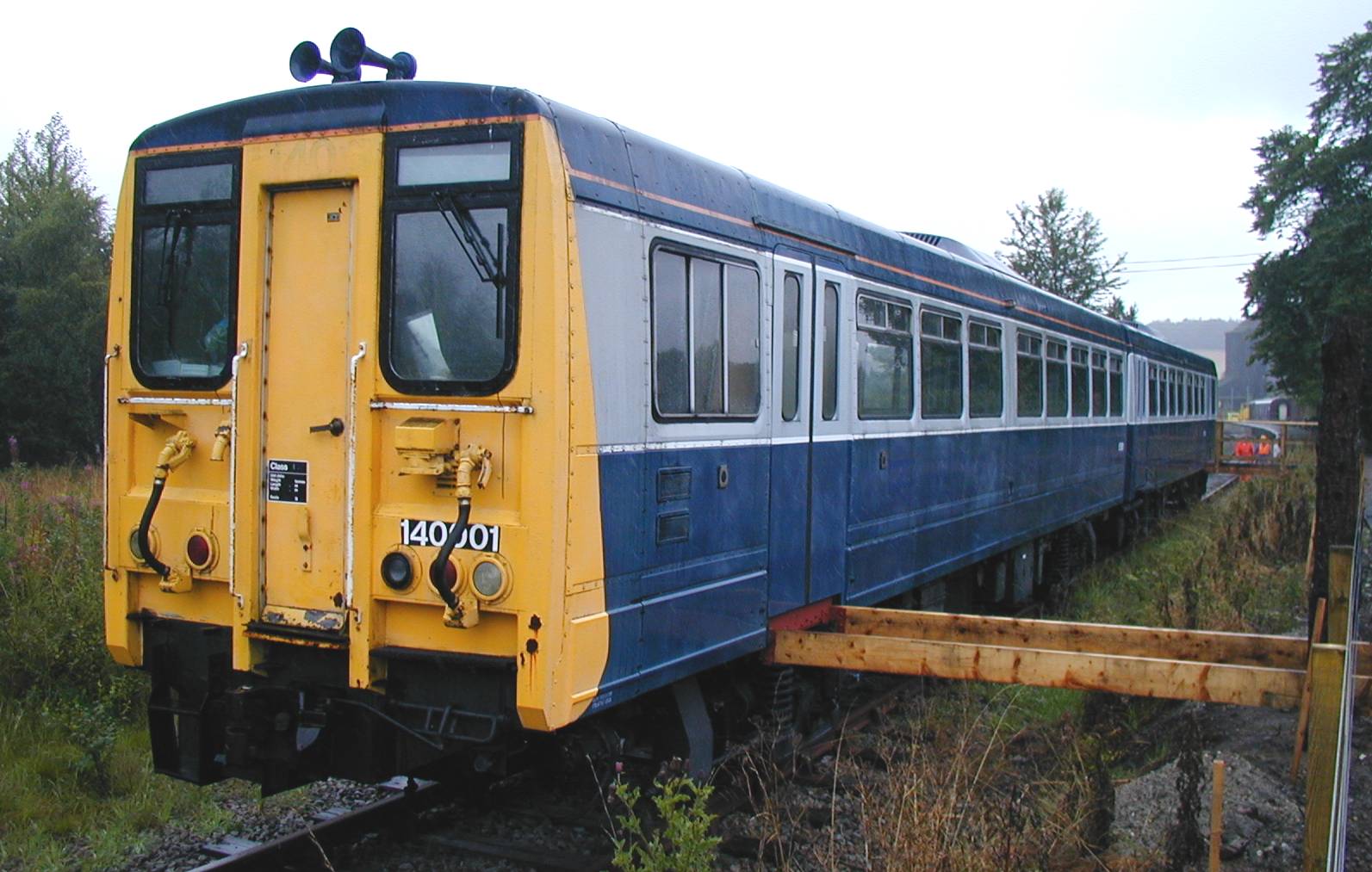 This important and unique prototype unit was built in 1981 and pioneered the use of road-bus bodywork on a railway chassis. The design was later developed into British Rail’s Pacer units of Classes 141, 142, 143 and 144. The unit ran for many years in evaluation service before entering use as a driver training unit at Neville Hill Depot, Leeds in 1985. Falling out of use, consideration was given to converting it to a Sandite unit, but this never took place, and the unit was withdrawn. The unit was moved to Dufftown in 1994 and is currently being restored as time and funds permit. Photo above shows the 140 at the buffer stops at Dufftown in the late 1990s. This site is now covered by our two road shed.
This important and unique prototype unit was built in 1981 and pioneered the use of road-bus bodywork on a railway chassis. The design was later developed into British Rail’s Pacer units of Classes 141, 142, 143 and 144. The unit ran for many years in evaluation service before entering use as a driver training unit at Neville Hill Depot, Leeds in 1985. Falling out of use, consideration was given to converting it to a Sandite unit, but this never took place, and the unit was withdrawn. The unit was moved to Dufftown in 1994 and is currently being restored as time and funds permit. Photo above shows the 140 at the buffer stops at Dufftown in the late 1990s. This site is now covered by our two road shed.
The Class 140 No.140001 had lain at the buffer stops at Dufftown for a several years, only receiving occasional attention. This is nothing against the 140! The available manpower and money must be focussed on the urgent necessity to keep the Class 108 DMUs in operation and carry out essential maintenance on our 11 mile line.
During the spring of 2012 the end of the line at Dufftown became a building site for our new engine shed. This meant that the 140 had to be moved out of the way, along the Dufftown platform and shunted into a siding. It then received some attention and has been given a spring clean, giving the exterior a good wash down and tidy up. There has been some water ingress through the roof, and this was attended to when the 140 was moved into the shed for the 150th Anniversary Steam weekend in October 2012. A repaint is being undertaken, but the 140 must take its place in the queue of priorities which are concentrated on our operational DMUs. The unit was sold to one of our Association members, in 2016, who will fund its remaining restoration. Photos show the progress on repainting as at April 2015.
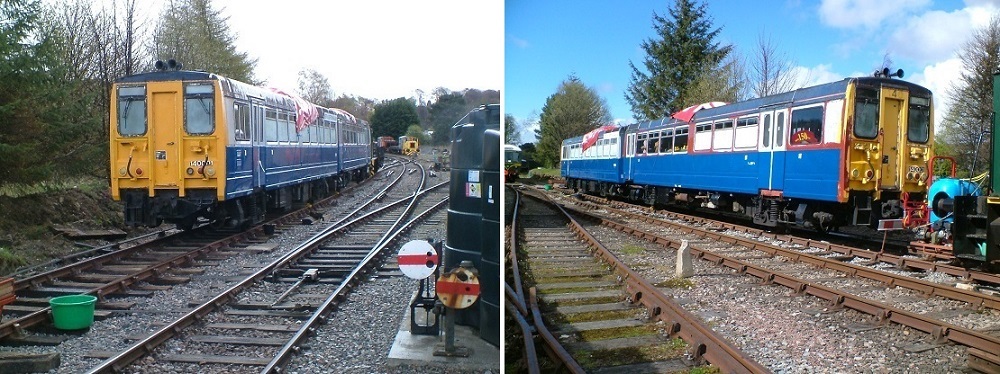
In October 2012 a compressor was attached and air put through the system, this proved successful and the doors were opened. Batteries have been connected and the lights persuaded to work. The engines have been barred over which is encouraging, although we suspect that one engine has a cracked cylinder head. The 140 engine was given three 10 second turnovers and it fired on the third on a couple of cylinders. No nasty noises were apparent so it was given a short while for the batteries to recover and on the fourth start the engine burst into life! It was held at low revs while the unit was looked over to see if there were any obvious problems. There were of course! Too many to mention but we now have an idea of what’s ahead. Hopefully it is not a cracked cylinder head but a gasket that is leaking, or condensation after standing so long exposed to elements? Many of the steel fuel pipes are rusty and a leak near the injector pump will take some time to replace. Also when the water system started to pump around a small but difficult to reach pipe showed up a leak under pressure. It probably did not drain when the unit was drained and stored, ergo it froze. The Lighting in the unit all came on when the alternators kicked in so we will get some batteries for the Aux circuits when money is available.
To summarize the Dufftown end car or 55000 is in remarkably good shape the Keith end car or 55001 still has a bad engine and until that is repaired there is only one useable engine. While the 140 was in the shed two KDRA volunteers waterproofed the roof vents and some seams which were allowing water ingress. Car 55000 (Dufftown car) is in remarkably good shape at the moment. The other car 55001 (Keith Town) has still a bad engine and until that is fixed and new pipework to replace some rusting fuel lines it will not be a runner unless on one engine. The second engine on 55001 will run but has either a cracked head a broken cylinder liner or a head gasket problem. There are spares for the second engine but finding shed time will be a problem with the bread and butter DMUs taking priority for shed time.
Industrial Locomotives
“SPIRIT O’ FIFE” English Electric 0-6-0 DM
Loco history by Colin Frost

This loco is on loan from UDV (Distilling) Ltd of Leven, Fife. It was built in 1967 by English Electric at Vulcan Foundry, Newton-le-Willows, Lancashire and delivered new to the Seaham Harbour Dock Co for transfer duties. With a works number of D1193, it was plated to operate over BR metals in this role, although would have done so only in exchange sidings. Rail traffic to Seaham ceased in 1989 and the loco was sold to Scottish Grain Distillers for use at the Cameronbridge Distillery. Overhauled in 1997, the loco saw another year’s service before rail traffic ceased to the site. The loco has been outshopped by UDV in their corporate yellow livery and the loco arrived at Dufftown on 15th March 2000.
“THE WEE MAC” Clayton 0-4-0 DM
 The first locomotive on the line under KDRA auspices was this Clayton 0-4-0 Diesel Shunter, known as “The Wee Mac”. The locomotive, built in 1979, spent its short career as a pilot at the Royal Navy Dockyard, Rosyth. It was bought and donated to the Railway by the Macallan Distillery, painted in their livery, complete with whisky bottle on the exhaust! (left photo above) The Wee Mac had been outside in all weathers for many years so its paint work was beginning to look increasingly shabby. The right photo, above, shows The Wee Mac in its current condition (2013) fitted with our weed killing spray rig. The name “The Wee Mac” has been retained in grateful recognition of the Macallan Distillery’s generous donation of the loco.
The first locomotive on the line under KDRA auspices was this Clayton 0-4-0 Diesel Shunter, known as “The Wee Mac”. The locomotive, built in 1979, spent its short career as a pilot at the Royal Navy Dockyard, Rosyth. It was bought and donated to the Railway by the Macallan Distillery, painted in their livery, complete with whisky bottle on the exhaust! (left photo above) The Wee Mac had been outside in all weathers for many years so its paint work was beginning to look increasingly shabby. The right photo, above, shows The Wee Mac in its current condition (2013) fitted with our weed killing spray rig. The name “The Wee Mac” has been retained in grateful recognition of the Macallan Distillery’s generous donation of the loco.
The Wee Mac was one of the first users of the shed where it was rubbed down, primed, undercoated and received its top coat. The following photos show the current condition of the loco.
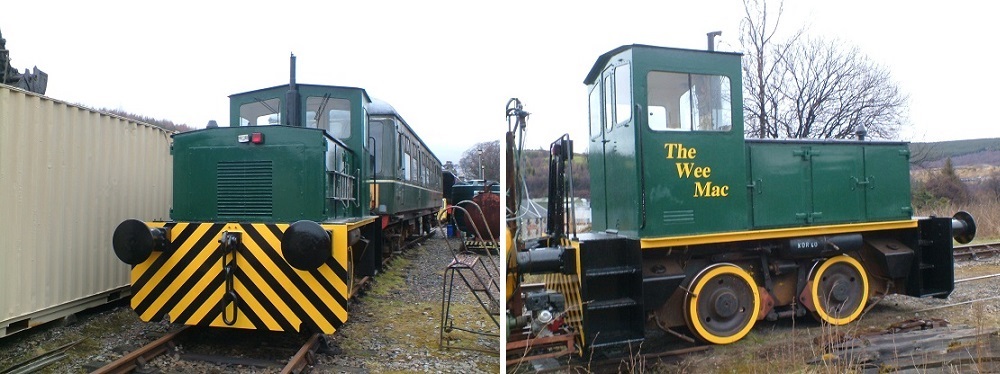
Andrew Barclay 0-4-0 Diesel Hydraulic
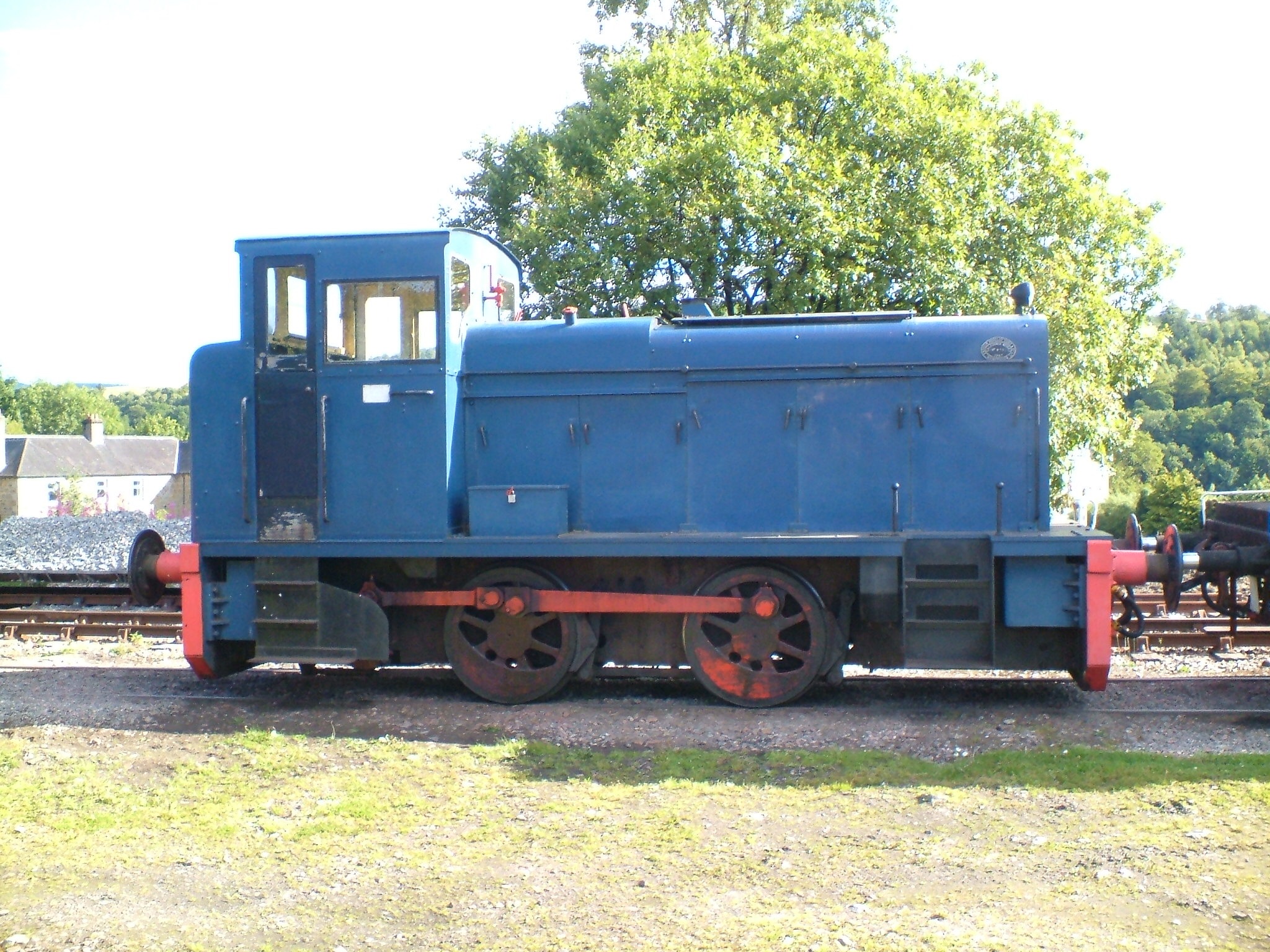
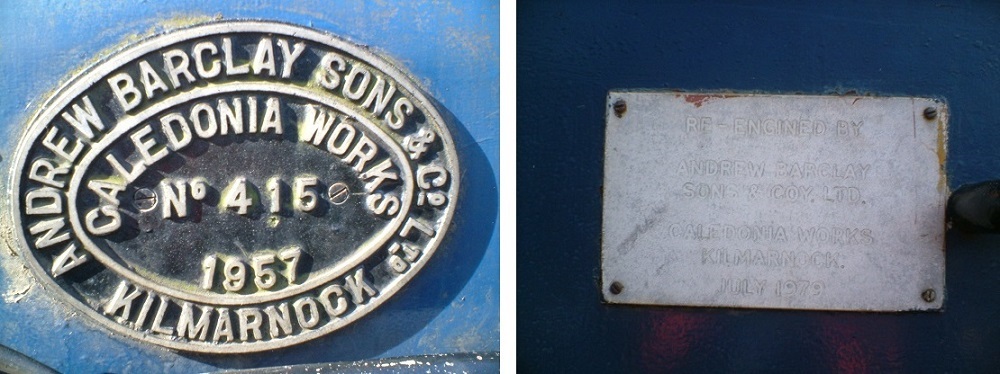
Built new for the recently formed British Electric Authority, by Andrew Barclay Works Number 415, it was delivered to Castle Donington Power Station in Leicestershire. The power station was opened in 1954 and Andrew Barclay number 415 was delivered in 1957. Originally fitted with 315h.p. National M4AAUL diesel engine driving the two coupled wheel arrangement through a mechanical gearbox, the locomotive was fitted with a straight air brake and a hand brake being designated Number 3. The locomotive weighed in at 37 tons.
Toward the end of the 1970’s the loco’s equipment was becoming unreliable and it was decided to have it re-built by the original builders Andrew Barclay. The loco was fitted with 355h.p. Turbo charged Cummins NTA855 engine. Additionally it was fitted with continuous train air brakes to allow the driver of the locomotive to control the air braked coal wagons now becoming prevalent on the rail system.
Following the closure of Castle Donington, Locomotive 415 was initially preserved at the Rutland Railway Museum at nearby Oakham in Leicestershire. In 2008, it was then purchased by volunteers at the Royal Deeside Railway where it was used to haul their BEMU (Battery Electric Multiple Unit), as the continuous air brakes were compatible with the unit.
In August 2015 the locomotive was put up for sale and acquired with the purpose of standing in as the works locomotive at the Keith and Dufftown railway while the two stalwart shunter’s the 0-6-0 English Electric and the 0-4-0 Clayton had some heavy maintenance carried out. It will also act as a recovery locomotive for the unique class 140 Diesel Multiple Unit should it fail on the mainline it also being air braked.
It is hoped to fit vacuum brakes at some point to make it compatible with our vacuum braked DMU and works train stock.
The Loco is similar in performance to the British Rail class 06 of which one was based at Keith yard in the late 1950’s and early 1960’s, coincidentally D2415.
The loco has had many colour schemes throughout its life and will no doubt receive another as time permits.
Coaching Stock
Mk 2f Tourist Standard Open “Spirit of Dufftown”
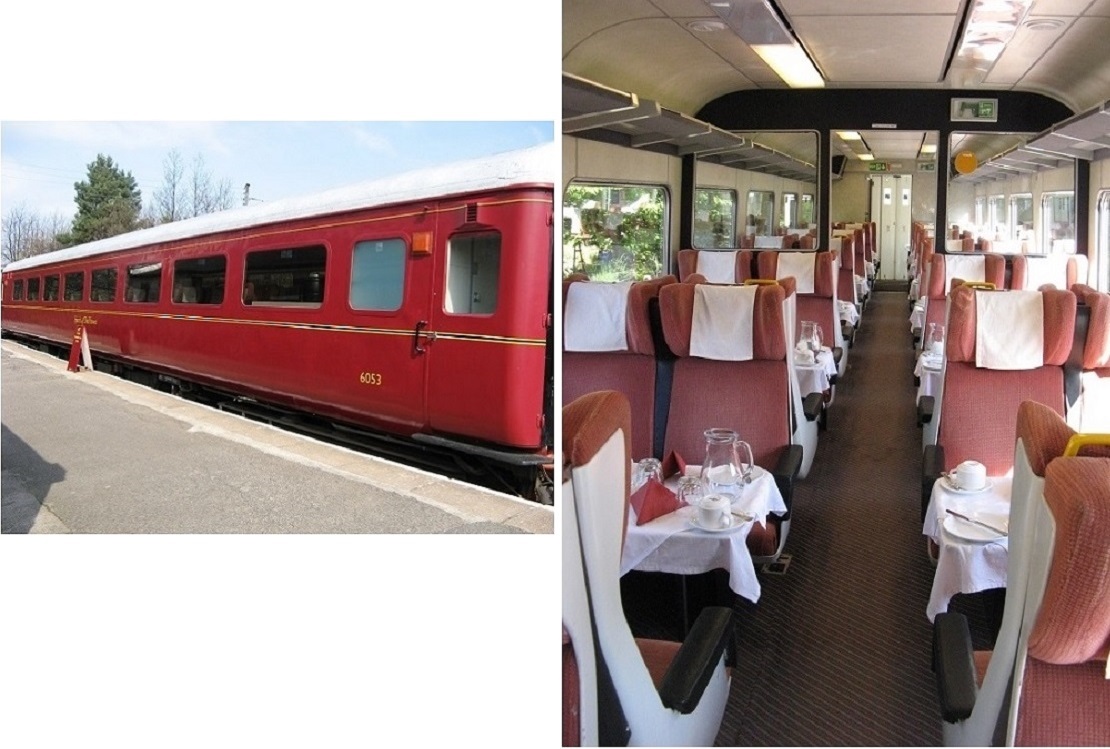
This Mark 2F coach, no 6053, dating from 1973 was one of 277 of this type built by British Rail Engineering Ltd (BREL). The coach entered service with BR Inter City and completed its main line service with Anglia Trains in approximately 2005. It was the stored for several years at MOD Kineton.
This coach arrived in March 2011 to replace the Pullman TTO Car 87 which was returned south to take its place in a restored 5-BEL train. The Mk 2f had been in store since 2006 and was still in the livery of its former operating company, Anglia.
The coach was thoroughly cleaned and some re-upholstery work undertaken. The first bay seating on either side has been removed and replaced with cupboard units to make a servery area. The coach was repainted into BR lined maroon and named “Spirit of Dufftown” soon after arriving. The “Spirit of Dufftown” is our exclusive Catering Coach run by the Keith & Dufftown Railway Association for charters and pre-booked groups in excess of 10 people.
Kitchen Car: BR Mk1, 81295
Carriage history by Colin Frost
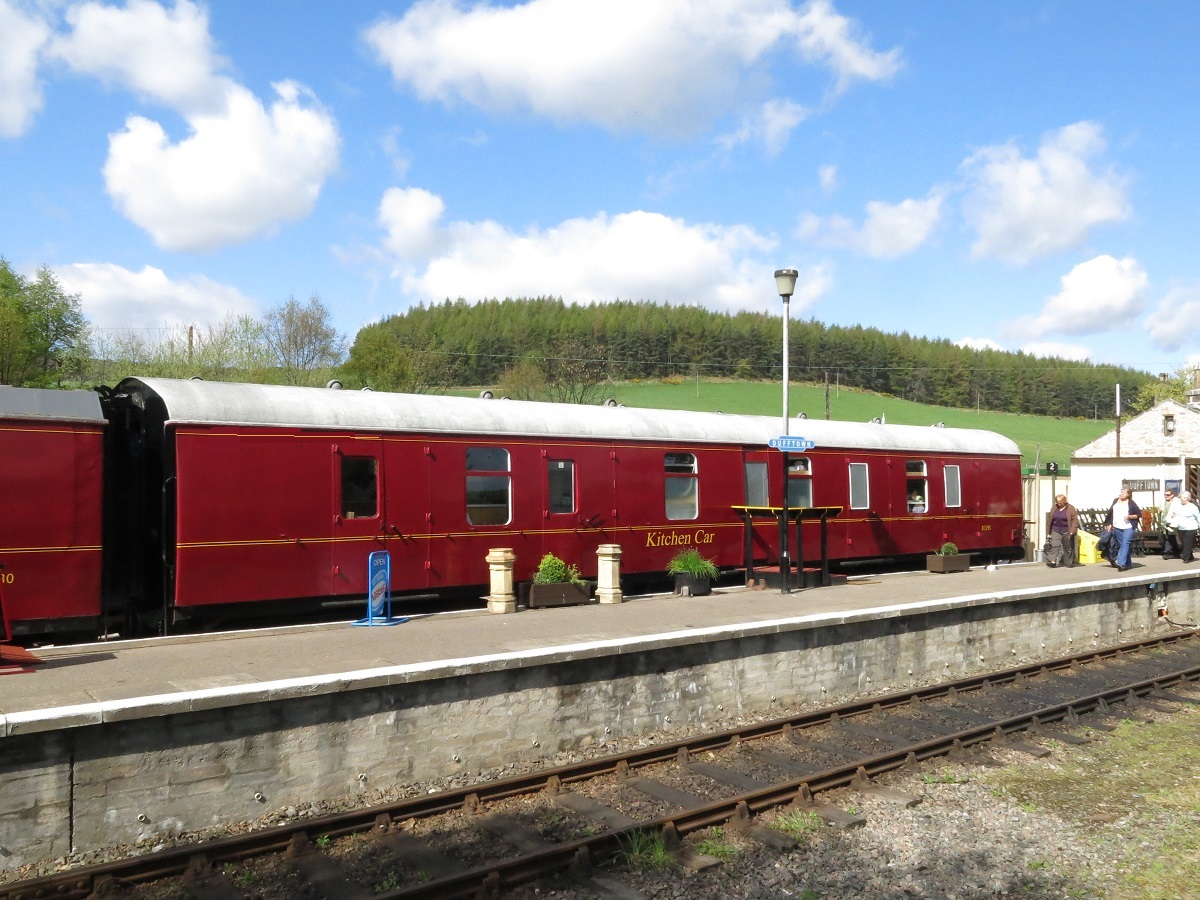
Built in 1957 by Pressed Steel at Linwood as a full guard’s luggage / parcels van, known officially as a Brake Gangway (BG). Following withdrawal it was acquired by the East Anglian Railway Museum and fitted with a kitchen and buffet counter. Having been used in this form for several years, it became redundant and moved to Dufftown on 15 June 2000 for continued static use in its converted role. A major rebuilding exercise was undertaken to bring the kitchen and serving area up to modern hygiene and safety standards, and car is now in operation at Dufftown.
Since then the coach has seen a continuous process of internal refurbishment to keep pace with current hygiene and safety standards. In 2011 the coach was repainted in BR lined maroon.
Cafeteria Car: BR Mk1, 975758
Carriage history by Colin Frost
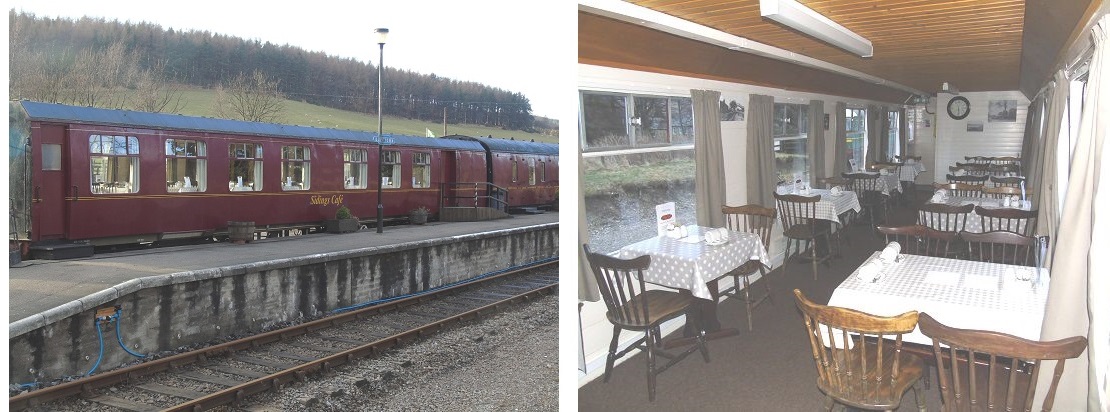
This coach was built in 1957 at BR Wolverton, numbered M25430. Formerly a Corridor Second seating 48 passengers in eight compartments, it was modified at Horwich Works to form part of an Overhead Line Maintenance Train based at Romford, Essex. The modifications included completely gutting the interior of all fittings and fitting with a flat roof with walking boards, which can still be seen. It was secured from Booth’s scrapyard in Rotherham for the Railway by members of The AC Locomotive Group, and moved to Dufftown on 14th June 2001. It is now fully fitted out with loose chairs, tables and curtains for its new role as a cafeteria, connected to the Kitchen Car, and was put into use in early 2002.
Since then the coach has seen a continuous process of internal refurbishment to keep pace with modern standards. In 2011 the coach was repainted in BR lined maroon.
PERMANENT WAY AND GOODS STOCK
Speeder Cars
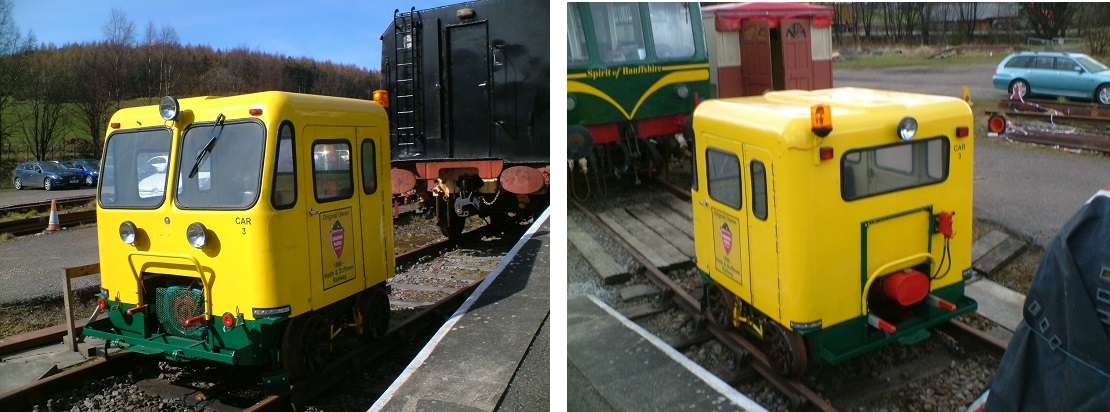
Fairmont MT14 Speeder Car 3
Left photo shows a front three quarter view of the Speeder. Right photo shows a back three quarter view of the Speeder.
Built in Fairmont, Minnesota in the USA by Fairmont Railway Motors Inc in the mid 1980s, Speeder Car No 3 was used on the Canadian Pacific Railway to enable track maintenance workers to quickly travel the line. Following shipment from Canada it arrived at Dufftown in 1997 and was used for small track maintenance tasks over the following few years. In 2010 it was the subject of a restoration programme and returned to service during late 2015. The
KDR has another 2 of these Speeder Cars with a similar history and these will also be subject to a restoration programme.
20 ton BR Brake Van B954819
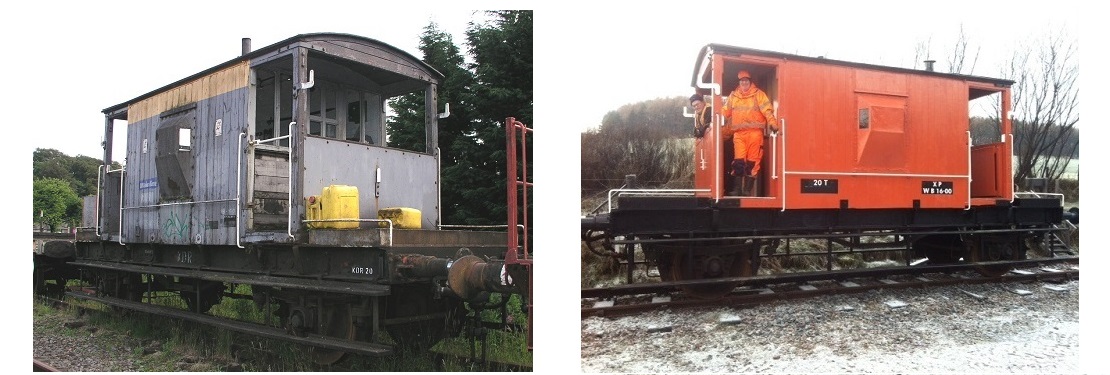
Left photo shows the brake van in the colour scheme as it arrived on 18/4/1999. Right photo shows the current state of the refurbished and re-painted van as at February 2016.
This vehicle was built at Faverdale Works, Darlington to diagram 507, batch number 3227 in 1959. Fitted with roller bearings, vacuum through pipe and vacuum brake setter from new, the van was delivered to the KDR from Toton, Notts on 18th April 1999. Needing little in the way of restoration apart from re-glazing and cosmetic touches the vehicle was put straight into traffic.
Both veranda ends were rebuilt by the KDR in August / September 2013. Half height doors were fitted to both verandas in May 2015. In late 2015 early 2016 the exterior planking of the body was refurbished and the van repainted as per right photo above. A new wood burning stove was also fitted in the van in January 2016.
20 ton BR Brake Van B953691
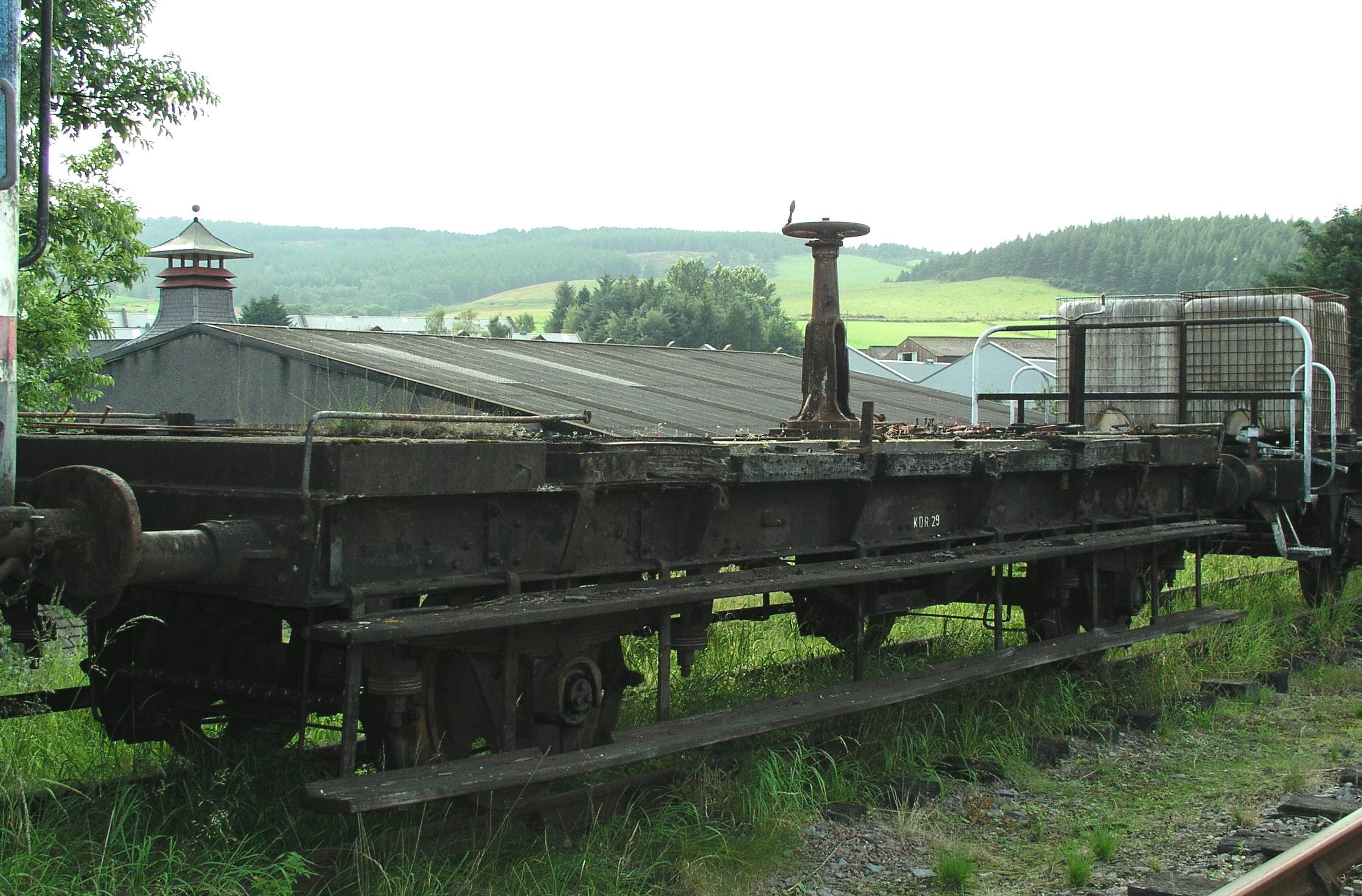
This brake van was built to a standard BR design which followed closely the pattern of the former LNER brakes. This vehicle was built at Faverdale Works, Darlington to diagram 506, batch number 3129 in 1958. The van would originally have looked very similar to our other brake van B954819 (see right photo above). While in use, as a departmental vehicle it was fitted with roller bearings at Perth Yard. Painted in red Bauxite colour it was stored at Craiginches yard at Aberdeen for some years, where the vehicle was used as a play thing by the local youth and the interior suffered at their hands. Whilst awaiting delivery to the KDR at Dufftown unknown persons started a fire within the vehicle, which caused even more damage. Luckily the fire was swiftly dealt with by the fire brigade, which limited the destroyed area to approximately 25% of the structure.
Moved to Dufftown on 24th January 1996 the vehicle was stored in the yard until February 1999 when it played an important part on the first crew training runs made by the KDR during February and March of that year. It continued in use as the active brake on works trains, in an unrestored and still charred state until the second van was delivered (see head of this section). At some point during the years 2000 to 2006 the damaged superstructure was removed with the intention of restoring it to its former state. These plans have never come to fruition and current thinking is to use the chassis as a base for a van for the engineering department.
WD Goods Vans

Closely modelled on the LNER design and built for the Ministry of Supply by Charles Roberts wagon builders of Wakefield, numbered 30418 & 30420, in 1940. They were registered as Private Owner wagons with the Great Western Railway numbered as 85112 and 85336.
These wooden chassis vehicles were purchased from a preservation society and delivered to Dufftown in 1995. The railway would be interested to learn more of the histories of these vehicles prior to their arrival at Dufftown and if anyone has such information please contact us.
Since their arrival at Dufftown the following work has been carried out on the vans:
October / November 2008 new doors previously constructed were fitted to both sides of both vans.
February to April 2009 new roof canvases were fitted to the vans.
June / July 2009 exterior planking was refurbished / replaced.
April 2010 the vans, which were green when they arrived were repainted grey. They were lettered K D R in July 2010.
The vans have seen much use on the railway being used, among other things, for the carriage of fencing materials and tools, carriage of permanent way materials and tools, and the transport of the wooden sections for the shelter on Drummuir platform.
24 ton Dogfish DB993309
Details by Brian McCormick
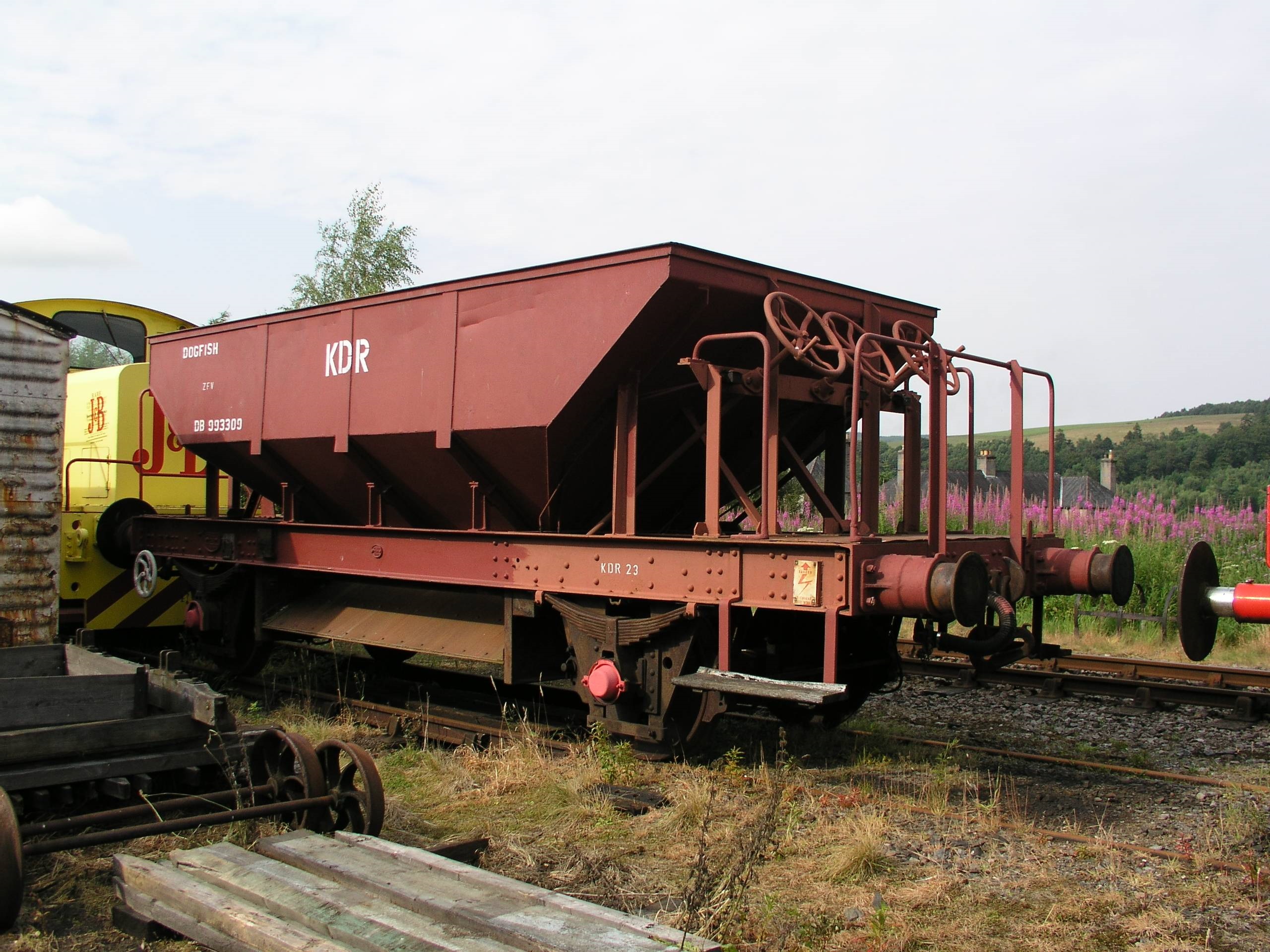
In early August 2001 the railway became aware of the availability of several ballast wagons lying at Perth North Yard including the Dogfish (this item) and Grampus (next item). These wagons were possibly for sale by EWS and contact was made with EWS disposals, Nottingham who requested numbers for the wagons required. In late August 2001 the KDR went to Perth North Yard and inspected the wagons and one Dogfish and two Grampus wagons were selected. The numbers of the wagons and an initial bid for them was submitted to EWS. A second bid had to be submitted before the offer was accepted and a written sale document was received on October 30th 2001,
EWS prepared the wagons for removal from Perth and in January 2002 they arrived at Dufftown. The wagons were transferred in two trips with the Dogfish arriving on the second trip.
The dogfish has three chutes for dropping ballast, one for each side of the track and one for the middle. The opening of the chutes is controlled by three wheels and rods at one end of the Dogfish. This vehicle is extremely useful to the KDR allowing ballast to be dropped where required on the move.
20 ton Grampus DB988241 & 20 ton Grampus DB988411
Details by Brian McCormick
 In early August 2001 the railway became aware of the availability of several ballast wagons lying at Perth North Yard including the Dogfish (previous item) and Grampus (this item). These wagons were possibly for sale by EWS and contact was made with EWS disposals, Nottingham who requested numbers for the wagons required. In late August 2001 the KDR went to Perth North Yard and inspected the wagons and one Dogfish and two Grampus wagons were selected. The numbers of the wagons and an initial bid for them was submitted to EWS. A second bid had to be submitted before the offer was accepted and a written sale document was received on October 30th 2001,
In early August 2001 the railway became aware of the availability of several ballast wagons lying at Perth North Yard including the Dogfish (previous item) and Grampus (this item). These wagons were possibly for sale by EWS and contact was made with EWS disposals, Nottingham who requested numbers for the wagons required. In late August 2001 the KDR went to Perth North Yard and inspected the wagons and one Dogfish and two Grampus wagons were selected. The numbers of the wagons and an initial bid for them was submitted to EWS. A second bid had to be submitted before the offer was accepted and a written sale document was received on October 30th 2001,
EWS prepared the wagons for removal from Perth and in January 2002 they arrived at Dufftown. The wagons were transferred in two trips with the both Grampus arriving on the first trip.
These wagons are very versatile having three drop down doors on each side and end doors which drop down onto the buffers. This allows material to be loaded and unloaded from either side or end. These wagons have been used for carrying many things including spoil and ballast. The Grampus are normally moved by one of our shunters but it is also possible to move them with the DMUs.
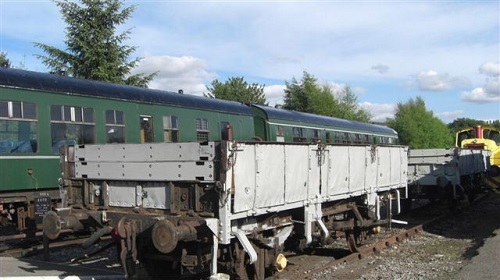
This photo shows the Grampus in pristine condition just after being re-floored and repainted in May 2009.
15 ton Lowmac (Low Machine Wagon) B905112
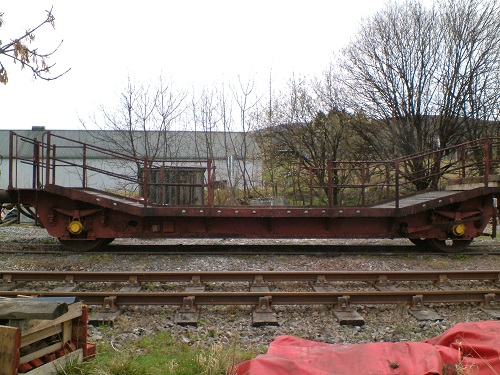
This wagon formed part of the series of Specially constructed Vehicles. This is a particularly rare vehicle being one of a total of only 510 examples built by BR which covered 14 separate diagrams over 30 different lots and were built over a span of ten years from 1950. This example was built at Swindon in 1958 to diagram 248 and was one of 19 built under lot number 3100, they were fitted with automatic vacuum brake. During its life this vehicle had the departmental prefix added to its number and was used to carry concrete products from the concrete works at Lenwade, on the Midland & Great Northern railway in Norfolk. The line to this factory closed in the early 1980’s.
It was lettered ZXV as a departmental vehicle, probably when it was fitted with a 48 hp diesel powered high pressure spray unit for tunnel wall cleaning and converted with side handrails, to protect the operatives working the unit.
In this configuration the vehicle arrived at Dufftown from Doncaster on 8th April 1999. The diesel unit was lifted off and the side handrails modified to allow for ease of removal and storage when use of the flatbed is required.

This photo shows the wagon in September 2008 when it had been repainted and was receiving a new floor. This is a very useful vehicle to the KDR and one which is important to the preservation scene as a whole as so few were constructed of this version.
Flatrol Wagon DB998017
Details by Owen Hodgson.
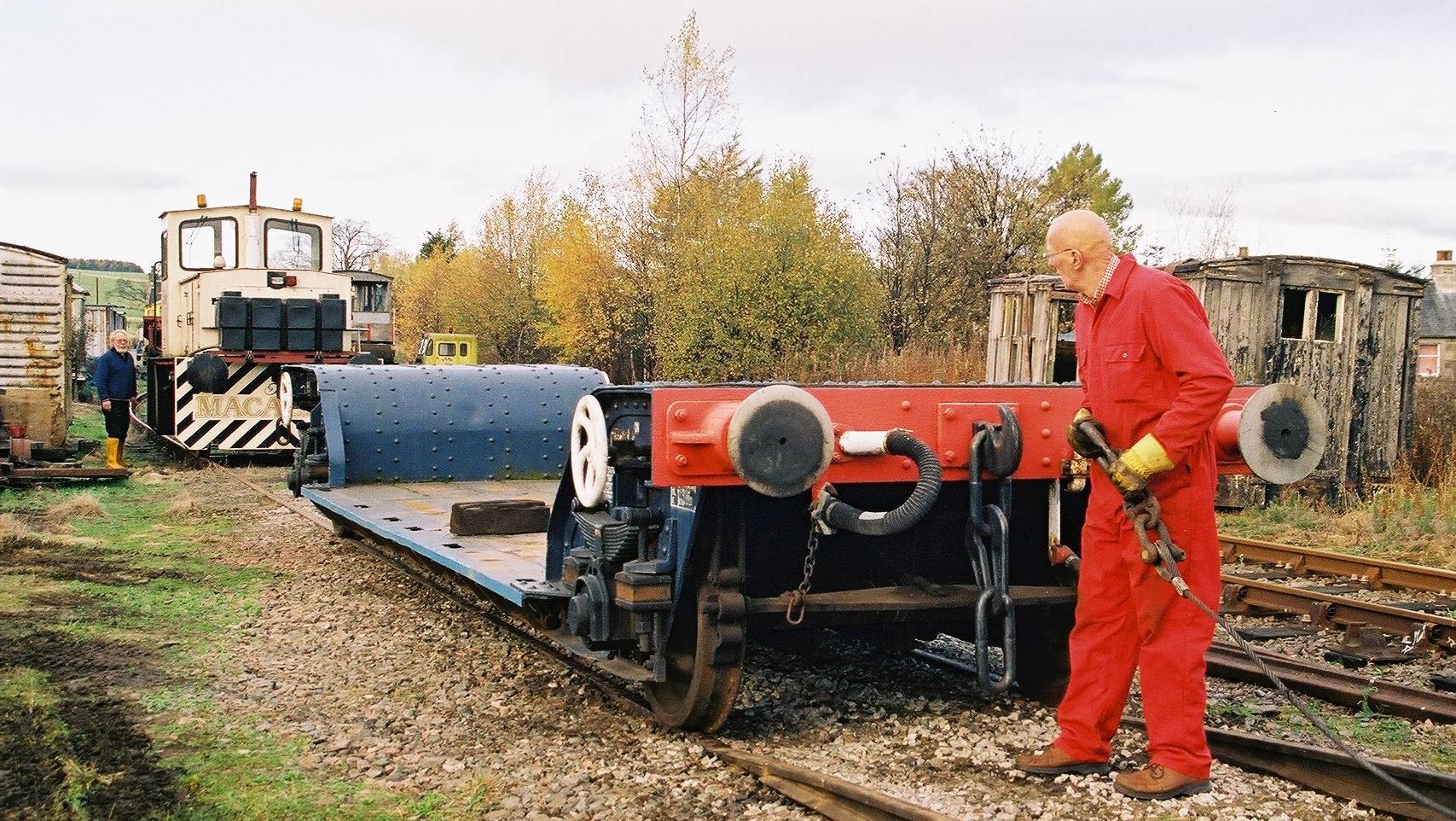
This photo shows the Flatrol being delivered in November 2004. Similar to a Lowmac (see above) the Flatrol was built by BR Lancing in 1959 and sent directly into departmental stock, being used to transport machinery such as diggers and other plant to work sites.

The Flatrol design has probably the lowest slung flatbed of any wagon type, and requires only a small ramp to allow vehicles to be driven on board. The above photo shows one of our Kubota diggers loaded on the Flatrol.
Little is known about its use on BR and later with EWS, although a photograph of it stabled at Carnforth appears in a 1984 book on departmental vehicles. It is fitted with handbrakes and has through pipes for air and vacuum brakes. After withdrawal it was sold to a preservationist at Barrow Hill, it became available for sale in late 2004 and arrived at Dufftown in November 2004.
50 ton Bogie Rail Wagon Salmon AB DB996996
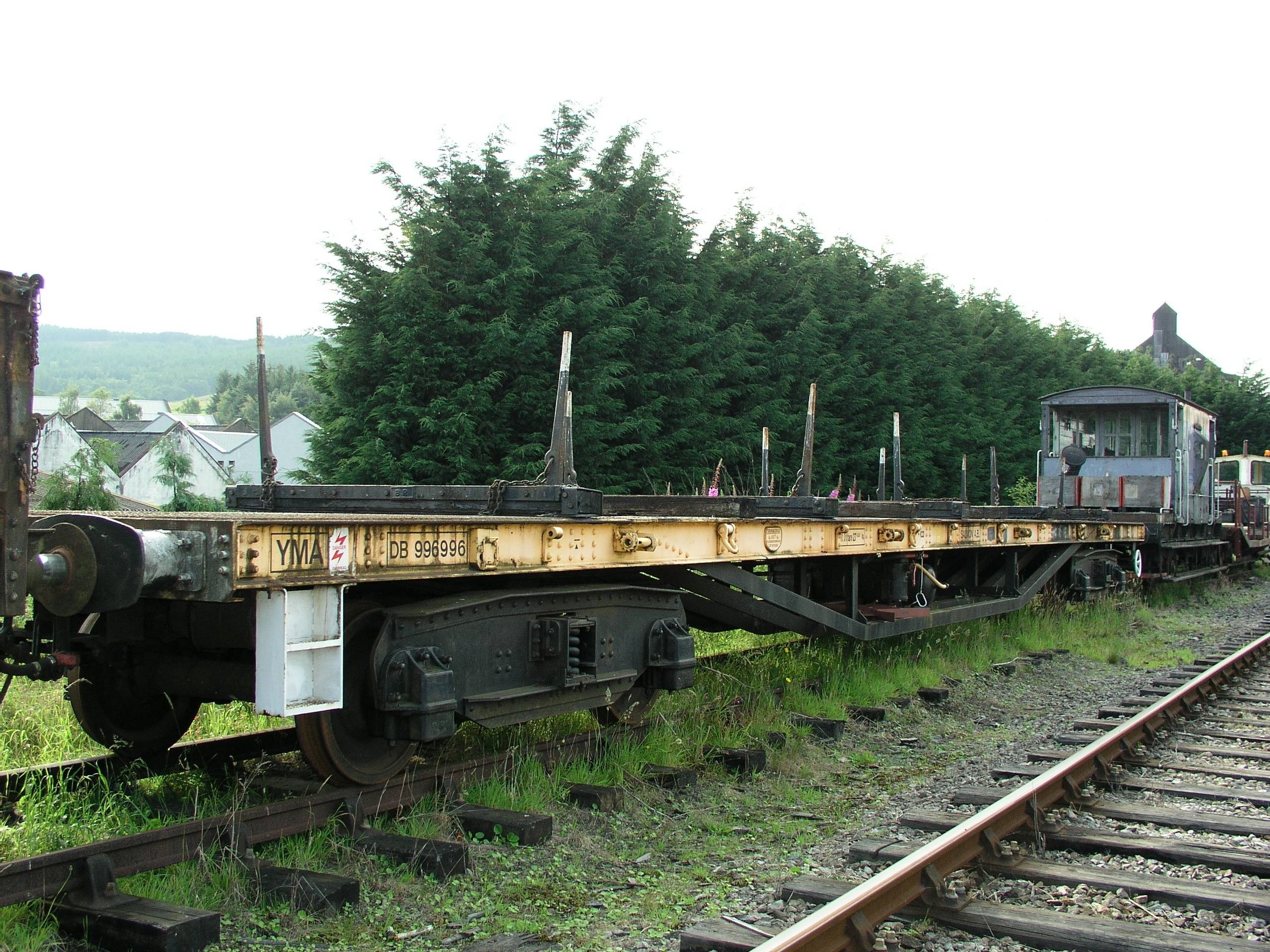
Falling under the general category of rail and sleeper wagons, this 50 ton bogie rail wagon was built at Middlesborough by Head-Wrightson in 1960 to diagram 637 under lot no. 3353. This was the last batch of 25 vehicles, from an overall total of 216 of the type that were completed in 1961 and the only batch built at this location. With a 65.5 foot overall length and a flat bed surface of 62ft this vehicle is immensely versatile. The vehicle is lettered YMA and carries as its base Perth, the yard from which it was delivered to Dufftown on the 16th March 2000.It is thought to have been based at Perth for some years and was stored there since at least July 1995.

Demonstrating the versatility of this wagon the above photos show the components for our shed which was dismantled at Drummuir in April 2011, loaded onto the Salmon and moved to Dufftown yard and from there to the new site for the engine shed, at the north end of Dufftown in April 2012.
This page last updated 10/04/23
